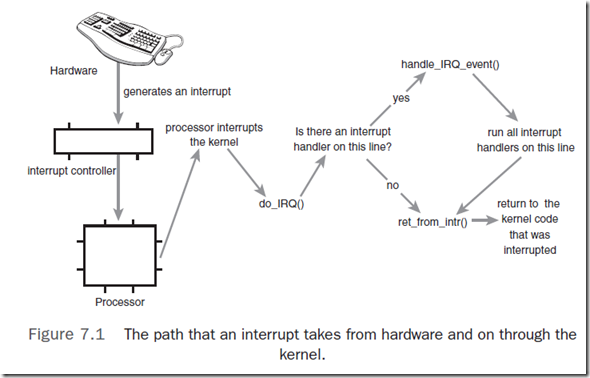Kernel Data Structures
The linked-list code is declared in the header file and the data structure is simple:
Usage is slightly different in kernel versions prior to 2.6.33—doublecheck before writing code
rbtrees The Linux implementation of red-black trees is called rbtrees.They are defined in lib/rbtree.c
Interrupts and Interrupt Handlers
Interrupt Handlers
The interrupt handler for a device is part of the device’s driver—the kernel code that manages the device.
Top Halves Versus Bottom Halves
These two goals—that an interrupt handler execute quickly and perform a large amount of work—clearly conflict with one another.
Because of these competing goals, the processing of interrupts is split into two parts, or halves.The interrupt handler is the top half. The top half is run immediately upon receipt of the interrupt and performs only the work that is time-critical, such as acknowledging receipt of the interrupt or resetting the hardware.Work that can be performed later is deferred until the bottom half.
Registering an Interrupt Handler
/* request_irq: allocate a given interrupt line */
int request_irq(unsigned int irq,
irq_handler_t handler,
unsigned long flags,
const char *name,
void *dev)On registration, an entry corresponding to the interrupt is created in /proc/irq.The function proc_mkdir() creates new procfs entries.
Writing an Interrupt Handler
static irqreturn_t intr_handler(int irq, void *dev)
Interrupt Context
Therefore, you cannot call certain functions from interrupt context. If a function sleeps, you cannot use it from your interrupt handler—this limits the functions that one can call from an interrupt handler.
Interrupt context is time-critical because the interrupt handler interrupts other code. Code should be quick and simple. Busy looping is possible, but discouraged.This is an
important point; always keep in mind that your interrupt handler has interrupted other code (possibly even another interrupt handler on a different line!).
Early in the 2.6 kernel process, an option was added to reduce the stack size from two pages down to one, providing only a 4KB stack on 32-bit systems.This reduced memory pressure because every process on the system previously needed two pages of contiguous, nonswappable kernel memory.To cope with the reduced stack size, interrupt handlers were given their own stack, one stack per processor, one page in size.
Implementing Interrupt Handlers
unsigned int do_IRQ(struct pt_regs regs)
kernel/irq/handler.c
/proc/interrupts
Interrupt Control
Because Linux supports multiple processors, kernel code more generally needs to obtain some sort of lock to prevent another processor from accessing shared data simultaneously.These locks are often obtained in conjunction with disabling local interrupts.
Disabling and Enabling Interrupts
local_irq_disable();
/* interrupts are disabled .. */
local_irq_enable();
In other words, they disable and enable interrupt delivery on the issuing processor.
Disabling a Specific Interrupt Line
All three of these functions can be called from interrupt or process context and do not sleep. If calling from interrupt context, be careful! You do not want, for example, to enable an interrupt line while you are handling it. (Recall that the interrupt line of a handler is masked out while it is serviced.)
Status of the Interrupt System
in_interrupt()
in_irq()
The most useful is the first: It returns nonzero if the kernel is performing any type of interrupt handling.This includes either executing an interrupt handler or a bottom half handler.The macro in_irq() returns nonzero only if the kernel is specifically executing an interrupt handler.






















 1373
1373

 被折叠的 条评论
为什么被折叠?
被折叠的 条评论
为什么被折叠?








